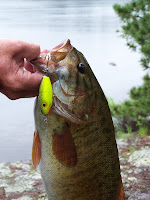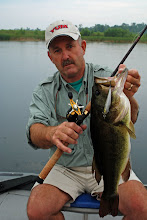






By Bill Cooper
Over 1,000,000 acres of pristine wilderness, filled with hundreds of lakes full of giant smallmouth bass, await the adventurous angler in Canada’s Quetico Provincial Park, just across the US border from the Superior National Forest. The two areas combined are referred to as the Boundary Waters Canoe Area.
The very mention of Canada, in fishing circles, conjures up images of vast reaches of wild country where people are few and fish are plentiful. Many anglers have the notion that one must venture to the far reaches of Canada to enjoy world class fishing. Not so for smallmouth. Some of the best smallmouth bass fishing on the planet exists in the Quetico Provincial Park on the northern US border.
Created in 1913 by the Ontario Ministry of Natural Resources, Quetico is a world class preserve. One legend says the word “Quetico” was borrowed from a Cree term describing a benevolent spirit, whose presence was felt strongly in places of great beauty. The meaning is a perfect fit for Quetico.
The Quetico Wilderness remained roadless until 1954, when one road was built into Dawson Trail Campground. All other entry points into the Quetico area are by water routes. The only travel routes in the interior of the park are portage trails established long ago by Native Americans.
Several species of fish may be caught in the Quetico region, including walleye, lake trout, Northern pike, crappie, perch, largemouth bass and smallmouth bass. Smallmouth bass have become the center of attention among anglers since the introduction of the species in the 1960’s.
Friends Justin and Greg Richardson joined me for a five day smallmouth fishing adventure into the bowels of Quetico. Both are avid smallmouth fishermen and canoers, but neither could realize what lay ahead.
Williams and Hall Outfitters hauled our gear and canoes from their lodge on Moose Lake, by boat, to the Prairie Portage entry point, where we cleared Canadian Customs. Williams and Hall have almost 30 years of outfitting experience. Blayne Hall mapped our route and wrote notes on our maps where the best smallmouth fishing could be found.
The magic of wild Canada enveloped us immediately. The remote Ranger Station at Prairie Portage quickly faded away to the strokes of our paddles as our party headed northwest out of Inlet Bay. We could have spent a day paddling up Moose Lake to the border crossing, but our anxieties to begin catching big smallmouth overruled excess paddling.
Clear, blue skies and hefty waves met us as we entered Bayley Bay on the eastern end of Basswood Lake. Determined to put miles between us and the entry point, we resisted the temptation to stop and fish. The broad expanse of Bayley Bay fell quickly to our paddles. Soon we approached our first portage at Burke Lake. We had selected this northern route to quickly remove us from Basswood Lake, one of the busiest in the entire Quetico Area. Having done our homework, we knew that only two parties per day were allowed to travel the route we had selected.
We held our rods until we reached the upper, narrow passage of Burke Lake. We soon began landing smallmouth bass in the 3-pound range. “This is incredible fishing; the best smallmouth I have ever caught,” Greg Richardson said. I casually informed him that much better fish lay ahead.
Resisting the urge to linger, I began paddling towards the next portage, which would put us into North Bay of Basswood Lake. Our planned goal was to reach Lost Bay, a small lake off the northwest corner of Basswood.
Rocky shorelines became more than I could stand. I had to start fishing. I tossed spinnerbaits and spider grubs to likely looking spots. The bite started slow. The wind picked up sharply making it difficult to hold the canoe. I switched to a pearl-colored Fluke and tossed it as the canoe drifted. Smallmouth attacked it with a vengeance. I marked the spot on my map.
Greg and Justin had paddled ahead, anxious to get a comfortable camp established. Greg served as camp boss. A division of labor paid off handsomely. Camp set-up proved a cinch.
The Richardson duo elected to explore Lost Bay. I paddled back two miles to pick up where I had left off, in spite of the wind blowing down North Bay.
I worked the leeward side of two islands to avoid the wind as much as possible. Strikes came at every cast of the Fluke. Smallmouth hid in the crevices between boulders, darting upwards to inhale the foundering Fluke. A slight twitch to make the bait dart and dive like a wounded minnow was all it took to entice strikes.
Clouds rolled in and dusk approached. I had to hug the western bank to paddle into a strong headwind. I lost ground every time I paused to cast. However, the extra paddling proved worth the effort. Smallmouth in the 3-to-4-pound range raced to the top of the whitecaps to snatch the Fluke.
A welcome break from the wind came when I turned the canoe into the western passage leading to Lost Bay. My partners had a cozy campfire going when I pulled ashore. Their excited voices crackled as they began telling their stories of the big smallmouth they had landed.
Rain began falling by the time we finished dinner. A steady downpour greeted us at dawn the next morning as well. We spent the next day and a half rushing out to fish during breaks in the weather. We were never disappointed in our catch, however.
The third day out produced the largest fish of the trip. All three of us kept our two biggest fish of the afternoon for photos. The legal limit is two fish per person per day to be used for meals. After photos, we released our smallmouth to fight another day. Of the six fish, none went under four pounds. Justin caught the largest smallmouth, a behemoth 27-inch fish. We estimated the brusier to weigh between 7 and 8 pounds.
“I never knew smallmouth got that big,” Justin said of his once in a lifetime trophy. “The Quetico area is an amazing fishery. Every smallmouth fisherman needs to make at least one trip here,” he added.
We kept thinking the fishing would slow, but smallmouth clobbered our baits everywhere we traveled. Flukes produced the majority of our fish, but other productive baits included Chompers, Booyah spinnerbaits, Rattlin’ Rogues, Sammy’s, Pop-R’s, Wood Choppers, Spit’n Images, Wiggle Warts and spoons.
Blayne Hall recommends planning a fishing trip to Quetico during the spawn. “That can occur anytime between the last week of May to the second week of June,” he said. “It all depends on water temperature, with 60 degrees being the magical number.
I have fished Quetico twice during the second week of June and experienced tremendous success. One advantage of fishing the spawn is being able to sight fish. I like using a flyrod during this time. Muddler Minnows, Clouser Minnows and streamers all produce fish.
Paddling out of Quetico on the last day of our trip cast a melancholy mood over our trio. We all wanted the adventure to last forever. “I will remember this trip for the rest of my life,” Greg stated, “especially the bear scare.”
“Ah, get over it, Greg,” I remarked. “It was only a charred, black stump.”
Planning a trip to Quetico Provincial Park may prove daunting to first timers. Utilizing the services of an outfitter is wise. Contact the Ely, Minnesota Chamber of Commerce for a list of outfitters. Or, if you want to begin planning your own trip, contact the permit reservation office at 888-668-7275. Permits may be acquired up to five months in advance. To acquire the route you want into Quetico, plan early. Only a limited number of people are allowed into the area each day.
If solitude, the rigors of wilderness canoe travel, incredible scenic beauty and big smallmouth bass appeal to you, the Quetico Provincial Park is a must for your destination list. Your paddle whispers. Your canoe glides.

No pictures of this 27" monster.....imagine that.
ReplyDeleteNo pictures of this 27" monster.....imagine that.
ReplyDeleteZooming in you can see the illegal barbed hooks - shame on you.
ReplyDeleteZoomed in, you can clearly see the barbs have been pushed flat, perfectly legal.
Delete